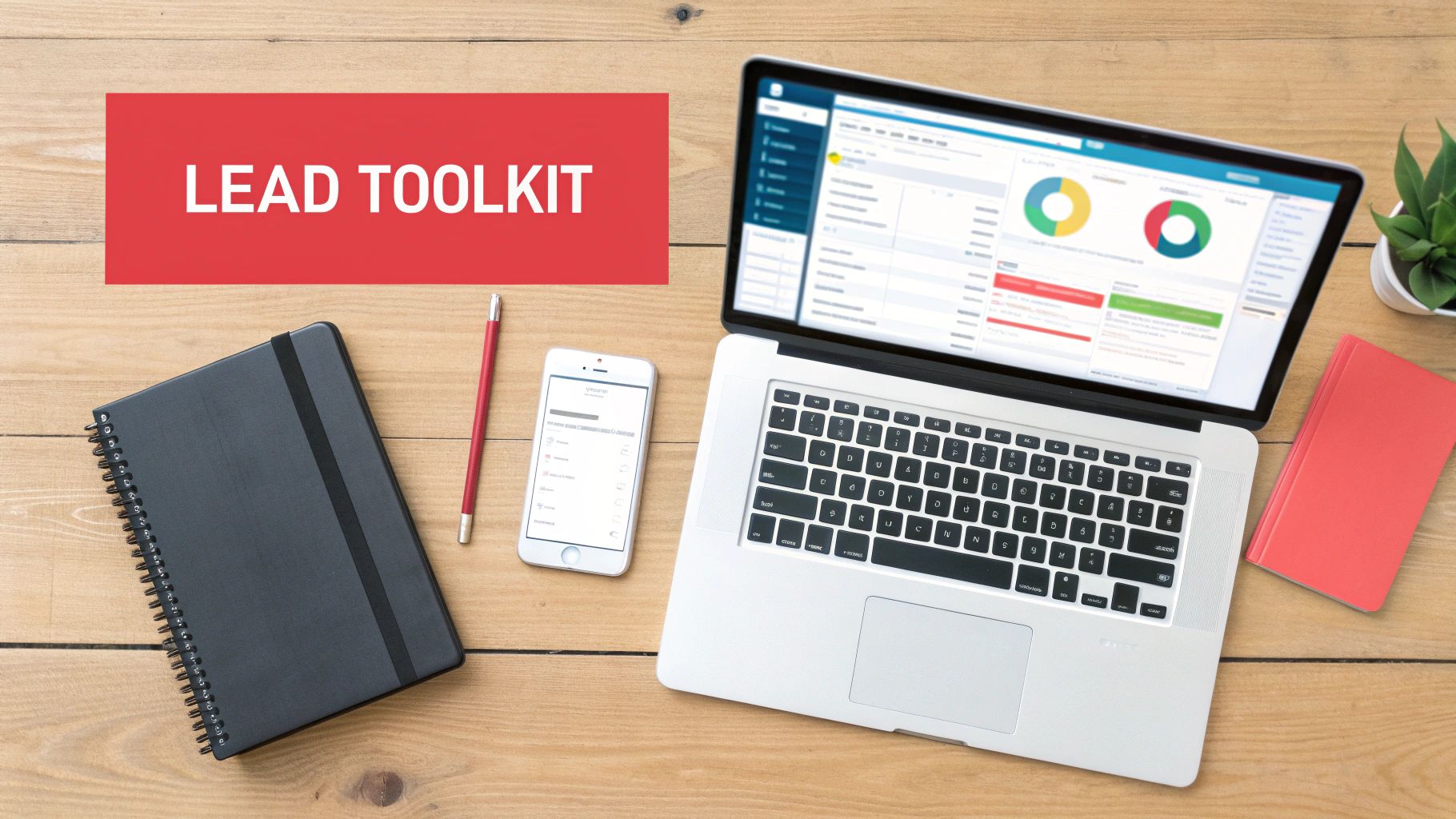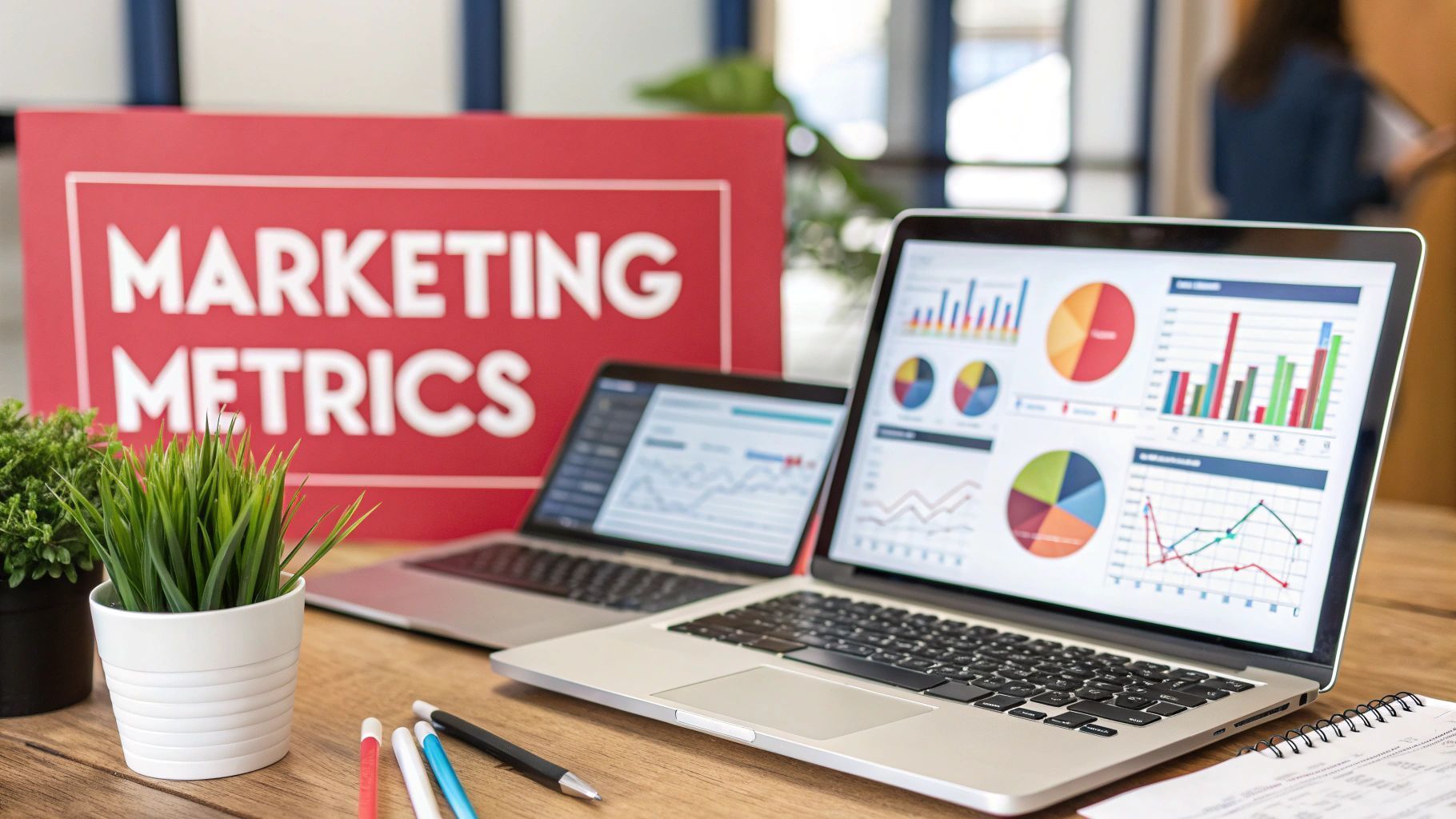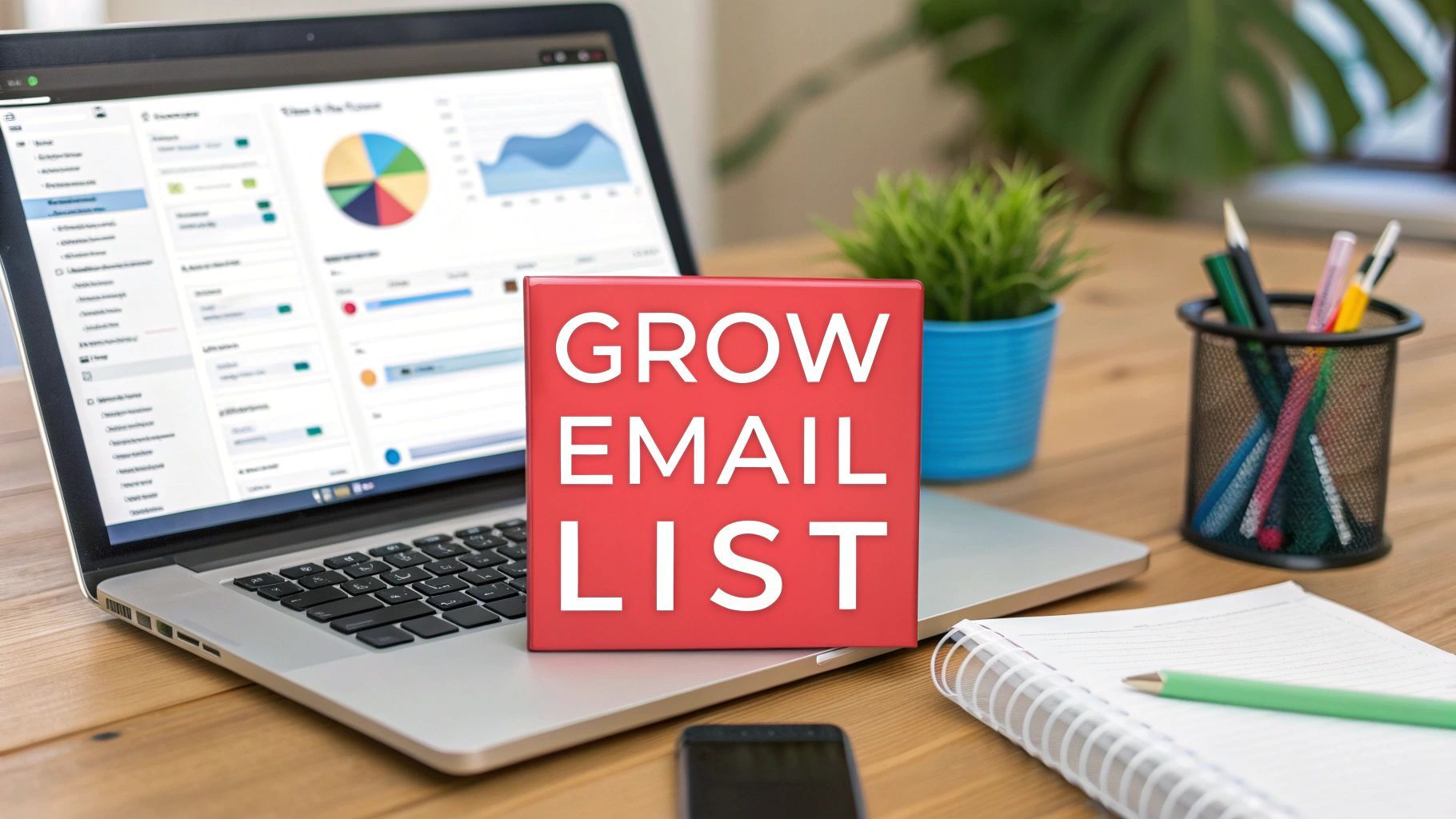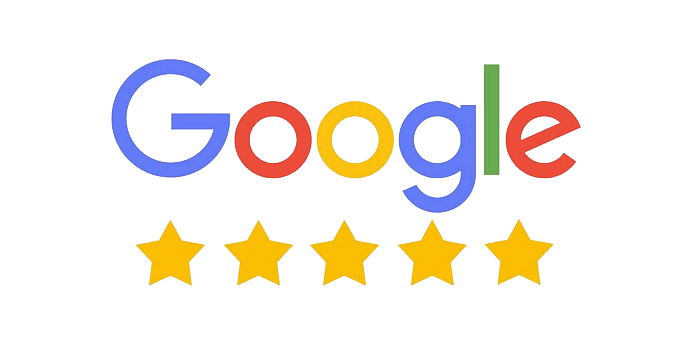Proven growth methods: lead generation for small business
Lead generation for a small business is all about identifying and attracting potential customers, then capturing their interest in what you do. It's the first and most crucial step in building a sales pipeline you can actually rely on, allowing your company to grow predictably.
What Is Lead Generation and Why It Matters for Growth
Think of your small business as a garden. You can have the best soil and tools in the world but without seeds, absolutely nothing will grow. Lead generation is the act of planting those seeds. It’s the intentional process of attracting people who have shown a genuine interest in your offerings and gently guiding them towards becoming loyal customers.
This isn’t about just hoping people stumble across your website or walk into your shop. It's a structured approach to creating a consistent flow of potential business. Without it, growth is a game of chance, relying on sporadic enquiries and unpredictable sales. With a solid strategy, you move from passively waiting for customers to actively building a pipeline of prospects.
The Foundation of Sustainable Success
A steady stream of leads is the lifeblood of any small business, fuelling every other part of your operations. When you have a reliable flow of interested people, you can forecast sales more accurately, manage your resources better and make smarter decisions about the future. It transforms your business from being reactive to proactive.
This diagram shows how leads are the central pillar connecting your sales activity to overall business growth.

As the infographic makes clear, a business can't achieve meaningful growth without first converting leads into sales. It really is that fundamental.
Beyond Just Finding Customers
Good lead generation offers benefits that go far beyond just landing the next sale. It's also a powerful way to understand your market and refine what you offer. Every single interaction provides valuable data about your audience.
A well-organised lead generation process does more than fill your sales funnel; it provides critical insights into your customers' needs, challenges and preferences, allowing you to serve them better and build lasting relationships.
Ultimately, this whole process is about creating opportunities. It allows you to:
- Increase Revenue: More qualified leads directly translate to more sales opportunities and a healthier bottom line. It’s a simple equation.
- Build Brand Awareness: By creating valuable content to attract leads, you simultaneously establish your business as a credible authority in your field.
- Gather Customer Insights: Leads offer feedback, revealing pain points and desires that can help you improve your products or services.
Essential Lead Generation Strategies for UK SMEs
Once you understand why a steady stream of leads is so vital, the next question is obvious: how do you actually get them? For UK small and medium-sized businesses, there’s no single magic bullet. Success comes from a smart mix of strategies working together to attract, engage and capture potential customers.
Think of it less like finding one perfect tool and more like assembling a well-stocked toolbox. This section is your guide to two of the most powerful tools available: building authority with great content and winning local customers with sharp Search Engine Optimisation (SEO).
Attract Leads with High-Quality Content Marketing
Content marketing isn't about the hard sell. It’s about creating and sharing genuinely useful information that your ideal customers are looking for. It's like offering a free sample of your expertise. When you provide real value, you build trust and position your business as the go-to resource in your field.
When someone sees you as a credible expert, who do you think they'll turn to when they're ready to buy? It’s no surprise that for 50% of marketers, generating leads is their number one goal for content campaigns.
For small businesses, sticking to what works is crucial. To explore this further, check out these proven B2B lead generation strategies, which break down methods that deliver real results.
Valuable content comes in many forms and each plays a part in your lead generation machine:
- Blog Posts and Articles: These are perfect for answering your audience’s burning questions. They show you know your stuff and help your website get found on Google.
- How-To Guides and E-books: A detailed, downloadable guide in exchange for an email address is a classic for a reason. It captures leads who are actively trying to solve a problem.
- Case Studies: Nothing builds confidence like showing how you’ve helped others. Case studies provide powerful proof that you can deliver on your promises.
The key is to create everything with your customer in mind. For a complete roadmap on how to create compelling content, our guide on content marketing for small business will get you started.
Master Local SEO to Capture Nearby Customers
For many UK SMEs—especially if you have a shop, office or defined service area—your best customers are right around the corner. This is where local SEO becomes one of your most powerful assets. It’s all about optimising your online presence to show up in relevant local searches.
Picture a homeowner in Devon searching for an "emergency plumber near me" or a tourist in Cornwall looking for the "best local pasty shop." Local SEO is what gets your business in front of them. The cornerstone of this whole strategy? Your Google Business Profile (GBP) .
Think of your Google Business Profile as your digital shopfront on the world's biggest search engine. A well-managed profile is one of the most powerful free lead generation tools you'll ever have.
But simply having a profile isn't enough. You need to treat it like a living part of your business. By actively managing and enriching it with the details customers want, you signal to Google that you're active and relevant. That effort is rewarded with better visibility in local search results and on Google Maps.
Optimising Your Google Business Profile
Ready to turn your profile into a local lead machine? Here are the essential steps. Each one plays a crucial role in turning curious searchers into paying customers.
- Complete Every Section Thoroughly: Don’t leave any blanks. Fill out your business name, address, phone number, website and opening hours with 100% accuracy.
- Choose Precise Categories: Select the primary and secondary categories that best describe what you do. This helps Google match you to the right searches.
- Upload High-Quality Photos and Videos: Show off your premises, your products, your team and your work. Visuals build trust and give people a real feel for your business before they even get in touch.
- Actively Encourage and Respond to Reviews: Good reviews are a massive trust signal. Make it easy for happy customers to leave feedback and always reply professionally—to the good and the bad.
- Use Google Posts Regularly: Share updates, special offers, events and news directly on your profile. This keeps your listing looking fresh and engages anyone who finds you online.
Turning Your Website Into a Lead Generation Engine
Your website should be your best salesperson, working 24/7 to pull in and qualify leads. It’s often the very first interaction someone has with your business, so it needs to do more than just look pretty. Transforming it from a digital brochure into a proper lead generation engine is a must for any small business serious about growth.
This means every single element, from the menu to the words on the page, needs to be geared towards one thing: getting your visitors to take action.
A website built for lead generation is clear, intuitive and quietly persuasive. It anticipates what your visitors need and makes it ridiculously easy for them to get in touch, download something valuable or make a purchase. Without that sharp focus, even the most beautiful website will fail to deliver real results.
For UK small businesses, a strong web presence is no longer optional. The numbers don't lie: companies with modern, optimised websites report revenue bumps of anywhere from 15% to 50% . These gains are overwhelmingly driven by better lead capture, with 90% of marketers pointing to their website as their number one tool. You can find out more about how optimised web experiences can double your leads and give your customer acquisition a serious boost.
Designing High-Converting Landing Pages
Think of your homepage as the front door to your business. A landing page, on the other hand, is a special entrance built for a single, specific purpose. Whether you want someone to sign up for a webinar or download your latest guide, its laser focus strips away all distractions, making it far more effective at turning visitors into leads.
A great landing page is a masterclass in persuasion. It speaks directly to a visitor's problem with a killer headline, compelling copy and an unmissable call-to-action. The design should be clean and simple, guiding the eye straight to the most important part of the page: the sign-up form.
To get this right, you need to understand what makes these pages tick. For a deep dive, check out our complete guide on the anatomy of a high-converting landing page and start building pages that actually get results.
Essential Elements of a Lead-Focused Website
To get your entire website working as a conversion machine, a few key elements need to work together flawlessly. Each plays a critical role in building trust and nudging visitors to take that next step.
To truly turn visitors into leads, your website needs several key components working in harmony. Below is a breakdown of the most critical elements and the role they play.
| Website Element | Purpose in Lead Generation | Best Practice Example |
|---|---|---|
| Compelling CTAs | Clearly directs visitors on what to do next, removing friction. | Using "Get Your Free Quote" instead of a passive "Submit." |
| Intuitive Navigation | Keeps visitors engaged by making it simple to find what they need. | A clean, logical menu with no more than 5-7 main items. |
| Mobile Performance | Ensures a seamless experience for the majority of users on phones. | A responsive design that loads quickly and is easy to tap through. |
| Lead Capture Forms | The primary tool for gathering contact information from interested visitors. | A short, simple form asking only for essential details (e.g., name and email). |
| Trust Signals | Builds credibility and reduces hesitation from potential customers. | Displaying customer testimonials, reviews or industry awards prominently. |
By weaving these elements throughout your site, you create a cohesive experience designed not just to inform but to convert.
-
Compelling Calls-to-Action (CTAs): These are the signposts telling people what to do. Use strong, action-focused words like "Download the Guide Now" instead of bland phrases like "Click Here."
-
Intuitive Navigation: If people can't find what they're looking for, they'll just leave. A simple, logical menu keeps them on your site longer and steers them towards your contact forms and offers.
-
Flawless Mobile Performance: Most of your traffic now comes from mobile devices. If your site is a mess on a small screen, you're throwing leads away. A clunky mobile experience is a guaranteed deal-breaker.
Your website’s primary job is not just to inform but to convert. Every button, form and headline should be meticulously crafted with the sole purpose of turning a passive browser into an active lead.
Engage Visitors Instantly with Chatbots
In a world of instant gratification, nobody wants to wait for an email response. This is where chatbots become an absolute game-changer for a small business's lead generation efforts. These handy automated assistants can engage with visitors the second they land on your site.
A chatbot can answer common questions, qualify leads by asking a few simple questions and even book appointments—all without you lifting a finger, 24/7. This immediate interaction stops potential customers from drifting away and captures their details while their interest is at its peak. By turning passive browsing into a helpful, active conversation, chatbots make sure you never miss another opportunity.
Building Your Small Business Lead Generation Toolkit

Running effective lead generation doesn't mean you need to juggle dozens of complicated software platforms. Far from it. The trick is to pick a handful of powerful tools that work together, helping you organise your efforts, automate the boring stuff and get the insights you need to make smarter decisions. This little collection of software is what’s often called a 'tech stack'.
Diving into the world of marketing technology can feel a bit overwhelming but building a solid toolkit is more straightforward than it sounds. The aim is to create a lean, cost-effective system that actually helps you grow without blowing your budget or stressing out your team.
You want tools that do the heavy lifting for you. This frees you up from manual admin so you can spend your time where it really counts: building relationships with potential customers. Let’s break down the three essential categories that form the bedrock of any strong lead generation toolkit.
Organise Your Contacts with a CRM
A Customer Relationship Management (CRM) system is the heart of your operation. Think of it as your digital black book—a central hub for every scrap of information about your leads and customers. It organises every single interaction, from the first time someone lands on your website to the day they become a loyal fan.
Without a CRM, vital details get lost in a mess of spreadsheets, chaotic inboxes and scribbled notes. A good CRM gives your business a single source of truth, tracking contact details, communication history and exactly where each lead is in your sales process. That level of organisation is absolutely critical for following up properly.
For small businesses, there are some excellent and surprisingly affordable options out there:
- HubSpot CRM: Kicks things off with a seriously powerful free version that’s perfect for start-ups. It helps you track leads and manage your sales pipeline without spending a penny upfront.
- Zoho CRM: Known for packing in a ton of features at a competitive price, it strikes a great balance between power and affordability as your business scales.
Nurture Leads with Email Marketing Platforms
Once you’ve captured a lead’s email address, the real work begins. This is where you start building a relationship and email marketing platforms let you automate much of that process, sending targeted, personal messages that keep your business at the front of their mind.
These tools are essential for nurturing leads without having to do it all manually. You can set up automated email sequences to welcome new subscribers, drip-feed them helpful content over time or announce special offers. This consistent communication builds trust and gently guides people towards making a purchase. In fact, some studies show email is still used by 32% of marketers for lead generation, proving its staying power.
A strong email marketing strategy transforms a simple list of contacts into an engaged community. It is your most direct and powerful channel for turning initial interest into profitable action.
A couple of popular choices for small businesses include:
- Mailchimp: Famous for its incredibly user-friendly interface, making it a brilliant starting point if you’re new to the world of email marketing.
- MailerLite: Offers powerful automation features and even landing page builders on its free and low-cost plans, giving you a lot of bang for your buck.
Understand Your Performance with Analytics Tools
You can't improve what you don't measure. Simple as that. Analytics tools are your compass, showing you exactly what’s working in your lead generation strategy and, just as importantly, what’s not. They give you the hard data you need to stop guessing and start making properly informed decisions.
By tracking key metrics, you can see how people are finding your website, which pages they’re visiting and what actions they’re taking. This information is gold for optimising your marketing efforts and making sure you’re putting your time and money into the channels that deliver real results. Tools like Google Analytics provide a deep dive into your website traffic and user behaviour, helping you fine-tune your approach for better lead generation.
How to Nurture Leads Into Loyal Customers

Capturing a new lead feels like a victory but it’s really just the start of the conversation. The real magic happens next, in the thoughtful follow-up process where you turn that initial spark of interest into a proper relationship. This is the art of lead nurturing and it’s arguably the most critical part of the whole game for any small business.
Lead nurturing is all about building trust and staying on their radar. Instead of jumping straight in with a hard sales pitch, you provide a steady stream of useful information that genuinely helps them solve their problems. It’s a way of proving your expertise and showing you care about their success, not just their wallet.
This patient, value-first approach is what separates businesses that struggle to convert from those that build a genuinely loyal customer base.
Automate Your Follow-Up with Email Sequences
One of the best ways to nurture leads without burning out is through automated email sequences, often called drip campaigns. Think of them as a pre-written series of emails that are automatically sent to a new lead over a set period. It’s your secret weapon for staying in touch without having to write hundreds of individual emails every week.
Let’s say someone downloads a guide from your website. Instead of that being the end of it, your system can automatically kick in:
- Day 1: Send an immediate thank you email with another link to the guide.
- Day 3: Follow up with a related blog post that offers a few more helpful tips on the same topic.
- Day 7: Share a case study showing how a similar business benefited from what you do.
- Day 14: Gently introduce a soft offer or an invitation for a no-obligation chat.
This simple flow keeps the conversation going and educates your lead over time, building their confidence in you piece by piece. Getting this right is vital, so if you want to dive deeper, you can learn more about email marketing best practices for 2025 success in our dedicated article.
Personalise Your Communication for Greater Impact
In a world drowning in generic marketing messages, a bit of personalisation makes you stand out. The more you can tailor your communication to a lead’s specific interests and behaviour, the more effective your nurturing will be. It just shows you’ve been paying attention.
This doesn’t have to be massively complicated. You can start by simply segmenting your email list based on how the lead found you. Did they download your guide on social media or the one about SEO? Make sure the follow-up content you send them relates directly to that initial topic.
The goal of lead nurturing is to be a helpful guide, not a persistent salesperson. By providing the right information at the right time, you build the trust required to turn a curious prospect into a confident buyer.
The stats really back this up. For small businesses in the UK, the average conversion rate from lead to customer is just 2.9% . But the data also shows that consistent nurturing makes a massive difference. In fact, nurturing can increase the likelihood of a purchase by a staggering 47% , which just shows how crucial that ongoing communication really is. You can discover more insights about the power of lead nurturing on seoprofy.com.
Use Social Media to Stay Connected
Lead nurturing isn’t just for email inboxes. Social media is a fantastic, informal way to keep building that relationship with your prospects. By sharing valuable content, joining in conversations and showing the human side of your business, you stay front of mind.
Here are a few simple tactics that work:
- Share Valuable Content: Regularly post tips, industry news and behind-the-scenes stuff that your audience will actually find interesting.
- Engage Directly: If a lead comments on your post, reply to them. Answer their questions and get involved in relevant discussions.
- Use Retargeting Ads: Show gentle reminder ads to people who have already visited your website, maybe offering them another piece of helpful content to keep your brand visible.
This multi-channel approach means you’re present wherever your leads hang out, subtly reinforcing your value and building a connection that lasts.
Measuring the Metrics That Actually Matter

You can't improve what you don't measure. It’s that simple. Once your small business lead generation campaigns are live, you have to track their performance to see what’s working and what’s just burning through your budget.
This isn’t about getting lost in spreadsheets. It’s about focusing on a few key numbers that tell the real story of your return on investment. Tracking the right metrics lets you make smart, data-driven decisions instead of relying on guesswork. It means you can double down on your most profitable activities and cut the ones that aren’t delivering.
The Core Metrics Every Small Business Should Track
To get a clear picture of what's happening, there are three core metrics you need to get comfortable with. These key performance indicators (KPIs) cut through the noise and show you the true financial impact of your lead generation work.
-
Cost Per Lead (CPL): This tells you exactly how much you spend to get a single lead. To figure it out, just divide your total marketing spend by the number of new leads you generated. So, if you spent £200 on an ad campaign and got 10 leads, your CPL is £20 .
-
Conversion Rate: This is the percentage of your leads that actually become paying customers. If those 10 leads resulted in two new sales, your conversion rate would be 20% . This number is crucial for understanding the quality of the leads you're attracting.
-
Customer Lifetime Value (CLV): This is a forecast of the total revenue you can expect from a single customer over their entire relationship with you. Knowing your CLV helps you figure out how much you can realistically afford to spend on getting new leads while staying profitable.
In the UK, small businesses put a good chunk of their budget into finding new leads, so keeping costs down is vital. Email is still a workhorse, used by 32% of marketers, while LinkedIn is the undisputed king for B2B, driving 80% of prospects from social media. You can dig deeper into UK lead generation stats over at snov.io.
Using Your Numbers to Make Smarter Decisions
Knowing your metrics is one thing. Using them to guide your strategy is what really counts. By checking in on these KPIs regularly, you can start tweaking your approach for better results and a healthier bottom line.
Understanding your CPL, Conversion Rate and CLV is like having a compass for your marketing. These numbers guide your budget, refine your targeting and ultimately lead to more profitable growth.
Think of it this way. If your local SEO efforts have a CPL of £15 but your social media ads have a CPL of £40, you have a clear sign of where your money is working harder.
From there, you can dig in and find out why one channel is outperforming the other and adjust your plan. This constant cycle of measuring, analysing and optimising is the secret to building a lead generation for small business system that actually works.
Got Questions About Lead Generation? We’ve Got Answers
Even with the best strategy in hand, a few questions always pop up once you start putting things into practice. It’s completely normal.
Let's tackle some of the most common queries we hear from small businesses. Getting these details right is what turns a good plan into real, tangible results.
How Much Should My Small Business Budget for Lead Generation?
There’s no magic number here. The right budget really depends on your industry, revenue and how fast you want to grow.
As a starting point, though, many small businesses find success by allocating between 20-40% of their total marketing spend to lead generation.
The most important thing isn't the amount you spend but the return you get. Start small. Pick one or two channels that look promising—maybe local SEO or some targeted social media ads—and see what happens. Track your Cost Per Lead (CPL) like a hawk. Once you find a channel that brings in quality leads for a price that makes sense, that’s when you confidently start investing more.
What’s the Difference Between an MQL and an SQL?
Think of it like dating. Someone might show interest (an MQL) but that doesn’t mean they’re ready to commit just yet (an SQL). Distinguishing between the two helps your team focus their efforts where it counts.
-
MQL (Marketing Qualified Lead): This is someone who’s dipped their toe in the water. They’ve downloaded your free guide or signed up for your newsletter. They're curious but they're not ready for a sales pitch.
-
SQL (Sales Qualified Lead): This is a prospect who’s raised their hand and shown they’re serious. They’ve asked for a demo or filled out a detailed form to get a quote. They have clear buying intent.
This distinction is crucial. It lets your marketing team keep nurturing the MQLs with helpful content, while your sales team can jump straight into conversations with SQLs who are much closer to buying.
How Long Does It Take to See Lead Generation Results?
Patience is a virtue but the timeline really hinges on your chosen strategy.
Paid advertising, like Google Ads or social media campaigns, can bring in leads almost instantly—sometimes within a few days. It's a great way to get the ball rolling.
On the flip side, organic methods like content marketing and SEO are a long game. Think of it like planting a tree; it takes consistent effort over several months, often three to six , before you start seeing a steady flow of leads.
That’s why a balanced approach usually works best. Mix in some short-term tactics for those quick wins while you build up your long-term strategies for sustainable, predictable growth. This creates a much healthier and more resilient pipeline for your business.
At Superhub , we specialise in creating lead generation systems that are built to drive real growth for UK businesses. Our strategies are grounded in data and deep industry experience, designed to build you a predictable pipeline of high-quality leads. Find out how we can help your business thrive.





